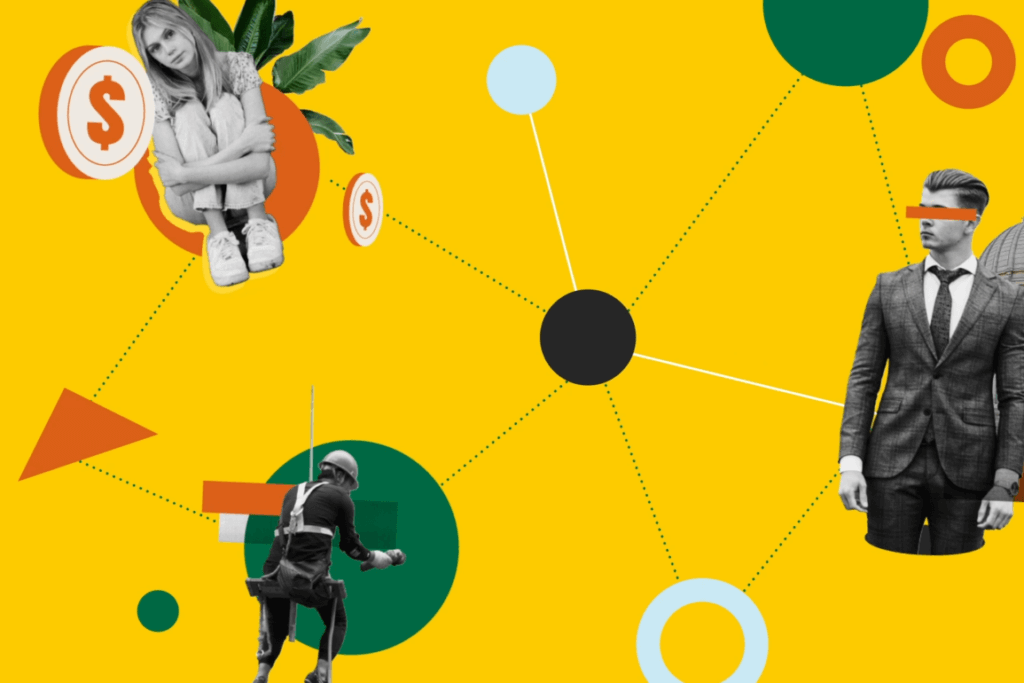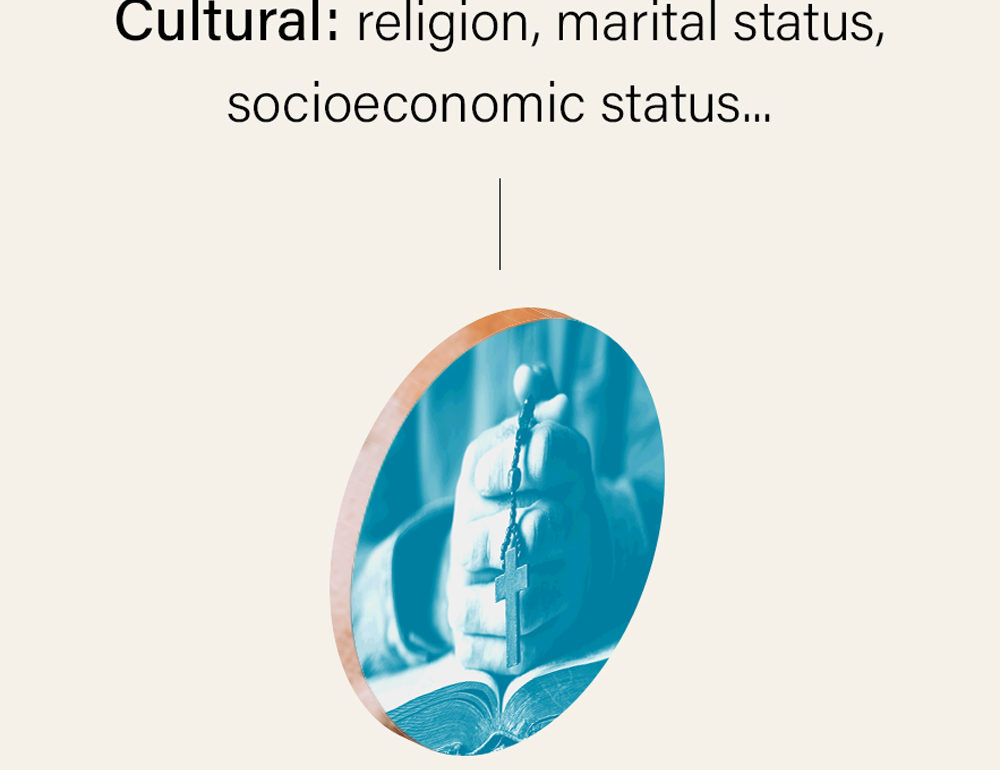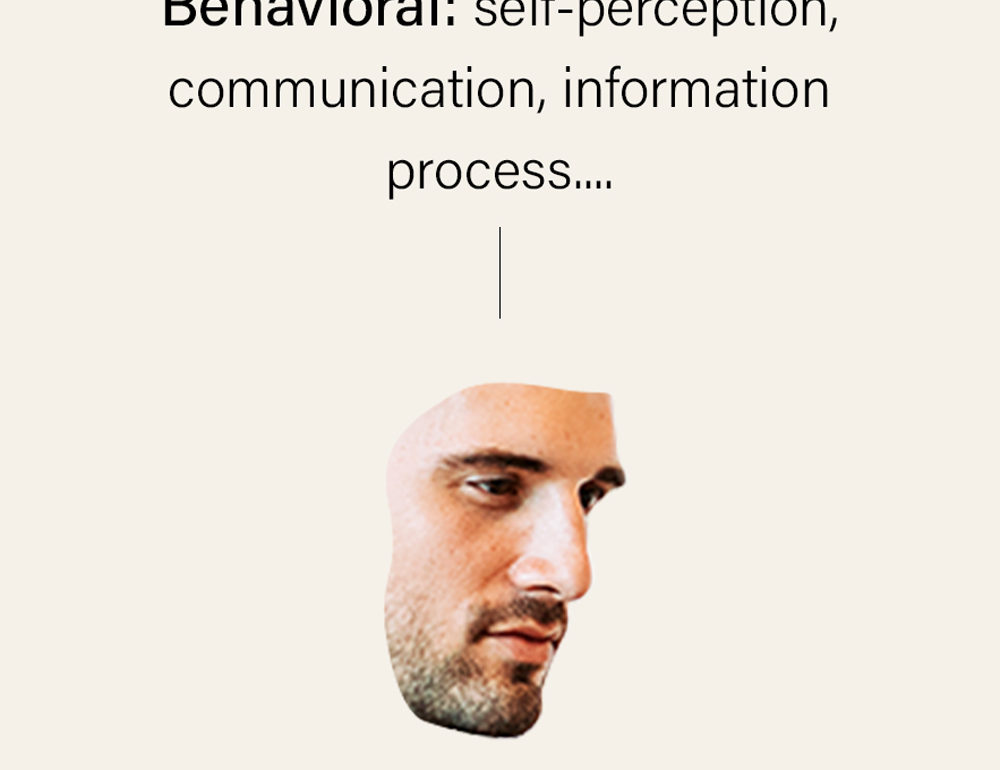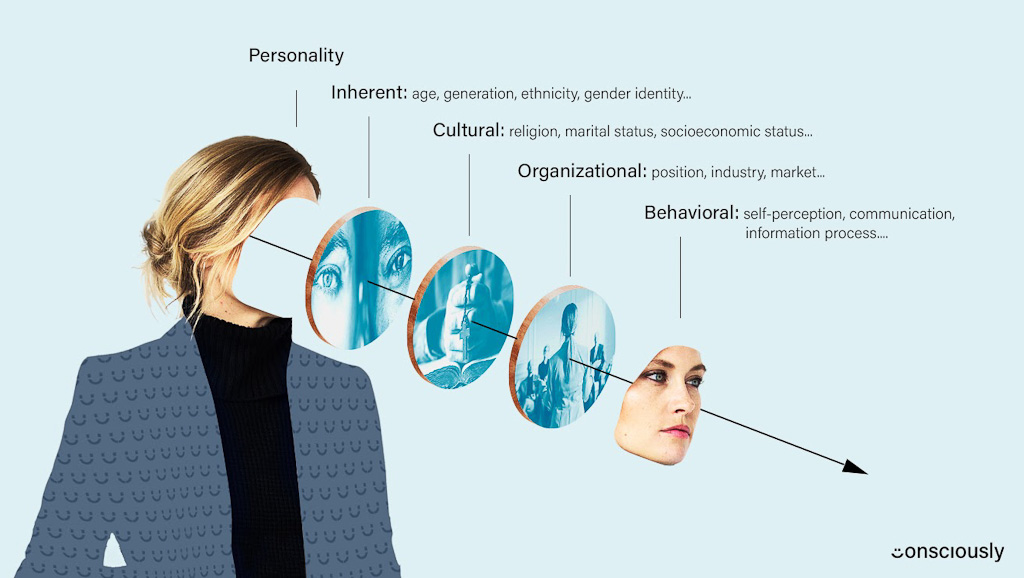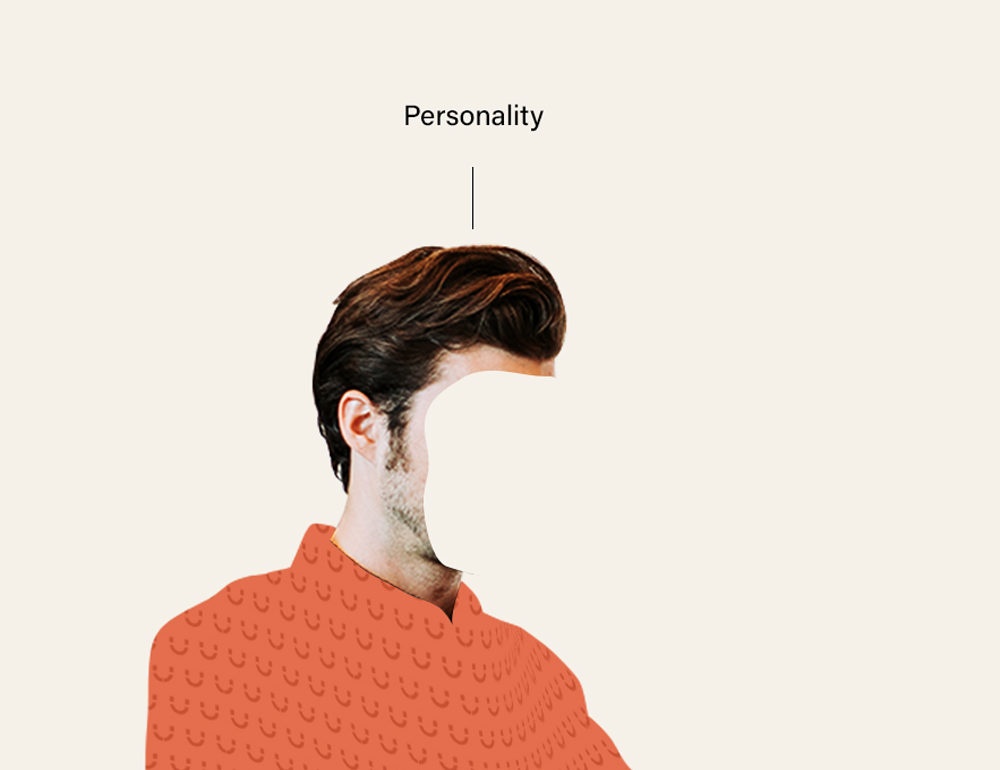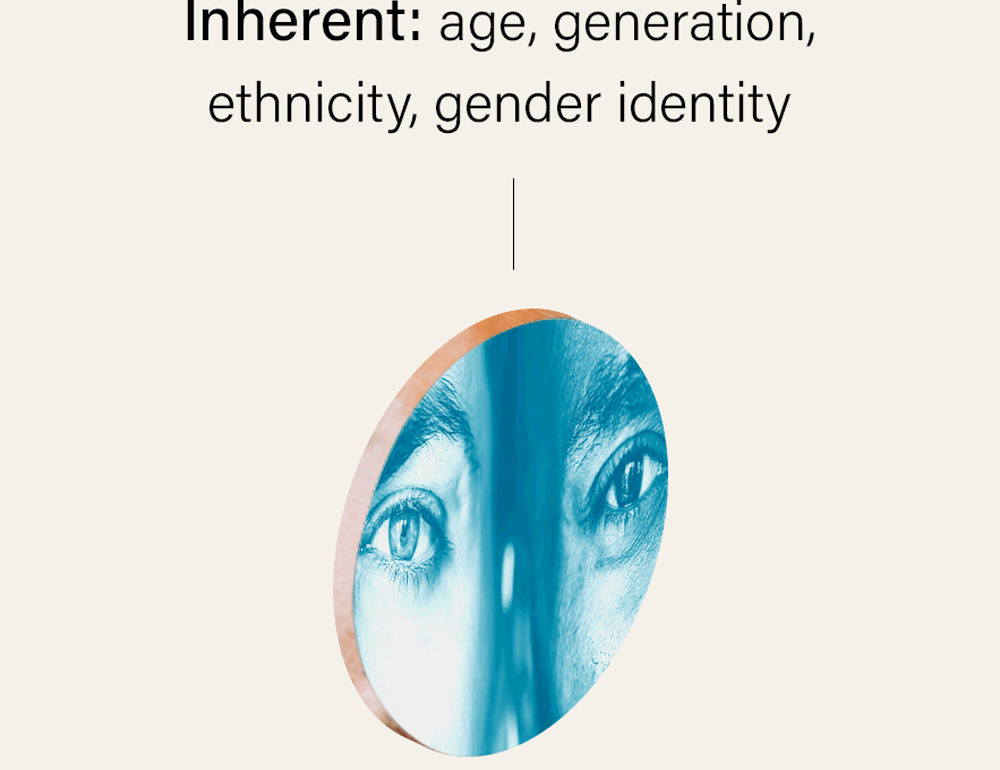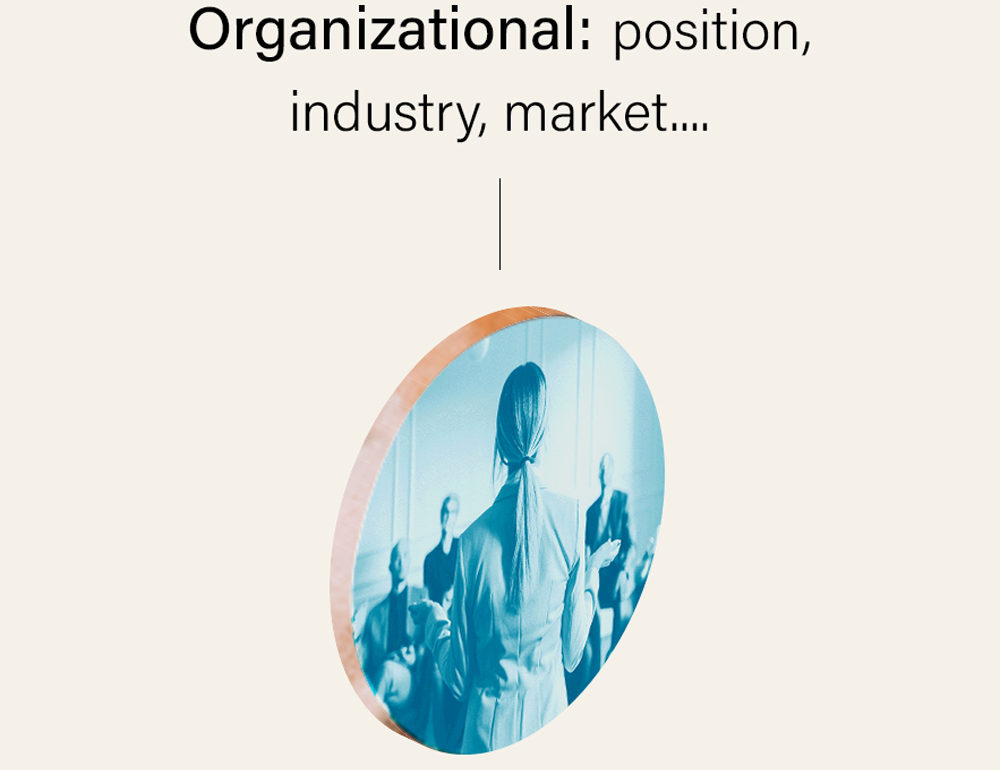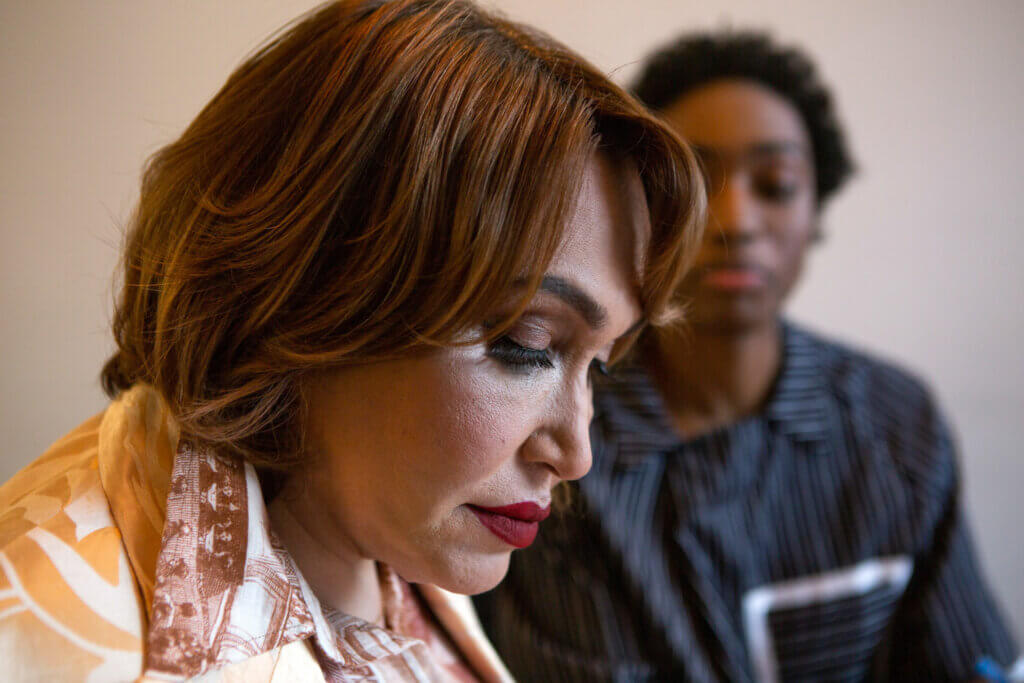How Unconscious Bias Effects Your Marketing Efforts

The main groupings of blind spots can be described as unconscious judgements based on: personality, visible characteristics, culture, organizational structure, and behavior.
Personality Blind Spots
Types IN people, instead of types OF people, is fundamentally important and relevant to unconscious bias. Personality models that speak to types OF people inherently invite “othering,” entitlement, and prejudice. The Process Communication Model (PCM), describes five types IN each of us, each with its own preferred way of seeing the world. Because we all have all five types IN us, there is no other. We are all connected, and all have within us the capacity to appreciate and connect with any other type.
Six Types of Personality and The Associated Unconscious Bias
These personality traits exist together in all of us. Some of these traits are more dominant than others, depending on the person. How does our own personality affect how we see others? Do you recognize your main personality traits? Can you recognize how these might affect how you see others?
- The Thinker views the world through data and information. Unconscious bias: Favors people who are logical, organized, and responsible. The thinker may look down on those who don’t think linearly, don’t value time as much, or have less logical ways of getting things done. They might think others can’t think clearly.
- The Persister sees through the lens of opinion and prizes commitment to values. Unconscious bias: Favors people who are dedicated, conscientious, and observant. May look down on those who don’t have clearly defined belief systems or change their mind when conditions change. They may feel others aren’t committed.
- The Harmonizer prizes relationships and compassion; they are nurtures. Unconscious bias: Favors people who are compassionate, sensitive, and warm. May look down on those who don’t show compassion and are non-emotional. They may feel others don’t care.
- The Imaginer prizes privacy and likes to reflect on the possibilities. Unconscious bias: Favors those who allow space and time to reflect, and may look down on those who are highly social and talking all the time. They may feel others just aren’t aware of what’s really going on under the surface and see them as shallow.
- The Rebel prizes spontaneity and fun and seek novel interactions. Unconscious bias: Favors those who are flexible and upbeat. May look down on those who are inflexible or wedded to plans and rules, and see them as boring.
- The Promoter values action, adaptability and self-sufficiency. Unconscious bias: They may look down on those who avoid risk, don’t take action, and struggle to adapt to changing conditions. They see others as weak.
Visual Characteristic Blind Spots
These types of blind spots include race, gender, ethnicity, age / generation, sexual orientation, gender identity, physical ability and gender expression. They are generally “in your face,” in that you can clearly see the color of someone’s skin, how old they are, whether they are male and female, etc.
Issues of sexual orientation may not be as openly visible, but we may judge others’ sexual orientation based on the way they are dressed or their mannerisms.
Let’s take these each in turn. Do you recognize yourself, an employee or a vendor? Because some of these terms can be confused with each other, it’s important to have clear definitions.
- Race bias. Racism can be conscious or unconscious. It can be individual or institutional. Individual racism is a personal belief in the superiority of one’s race over another. It is linked to racial prejudice and discriminatory behaviors, which can be an expression of implicit and explicit bias.
- Institutional racism in a business context, shows up as a system of assigning value and allocating opportunity based on skin color. It unfairly privileges some individuals and groups over others.In business, it’s reflected in disparities in, things such as, income, employment, and opportunities for promotion. It can be expressed implicitly or explicitly and occurs when a certain group is targeted and discriminated against based on race. For example, you might see only one race in upper management. This is an obvious result of something systematic.
- Gender bias is a preference or prejudice toward one gender over the other. It can manifest in many ways, both subtle and obvious. Examples of gender bias in business include wage disparities among different genders doing the same job with the same qualifications, and leadership roles primarily filled by one gender.
- Ethnic bias is defined by cultural heritage. It’s often confused with race, but it’s not the same thing. Someone might be white, for example, but their ethnicity is Jewish or Polish. Race is a social construct that brings together skin color, heritage, and historical context.
- Age / Generational bias. Most of us hang around with people who are “like us,” who share commonalities in background, personality, interests, and age. In the workplace, this can become a problem, as it can lead managers to jump to conclusions or make decisions about employees that they don’t even realize they are making, based on beliefs about generations or cultures.
- Gender identity. This doesn’t mean transgender. Gender identity refers to a person’s internal sense of being male, female or something else. They use gender expression to communicate gender identity to others through their behavior, clothing, hairstyles, voice or body characteristics. Gender identity is fundamentally different from and not related to their sexual orientation.
- Physical / Mental ability. Implicit biases about persons with disabilities are prevalent. One study found that “preference for people without disability compared to people with disabilities was among the strongest implicit and explicit effects across the social group domains” (e.g., gender, race, religion, sexuality, weight, political orientation, etc.), with only age showing more implicit bias. And, 76% of respondents showed an implicit preference for people without disabilities, compared to nine percent for people with disabilities. Even test takers with disabilities showed a preference for people without disabilities.
- Gender Expression is how a person publicly expresses or presents their gender. This can include behaviour and outward appearance such as dress, hair, make-up, body language and voice. A person’s chosen name and pronoun are also common ways of expressing gender.
Cultural Blind Spots
Cultural bias is the interpretation of any phenomena based on one’s own cultural standards. It also refers to the bias created due to the norms of the majority ethnic group.
It includes misconceptions, prejudices, or beliefs that we have toward other people, communities, or countries. Things like books, movies, travel, food, or lifestyle introduce us to the non-familiar aspects existing in the world outside. Cultural bias is just like viewing the ‘other’ with ‘our’ glasses on.
Some examples of cultural bias include:
- When we judge everyone by the norms of their own culture and consider our own culture to be superior to that of the other. Examples include:
- Socio-economic status
- Marital status
- Partner status
- Parental status
- Military / Veteran status
- Religion
- Education
- Nationality – even when people “look” the same
- When we judge everyone by the norms of their own culture and consider our own culture to be superior to that of the other. Examples include:
- Physical Appearance: The color of skin is the predominant factor in developing a bias everywhere in the world.
- Language: Cultural bias can be reflected through a clash of accents. Research shows that we tend to unconsciously group people into a specific social class and have a bias against them based on their accents. It takes us less than 30 seconds to linguistically profile a speaker and make quick decisions on their ethnic origin, socio-economic class, and their backgrounds. We’re more likely to be biased against speakers who have accents different to ours or we consider markers for undesirable characteristics that we unconsciously attribute to certain accents.
- Gender Expression: We’ve learned that gender expression is how a person publicly expresses or presents their gender. Gender expression bias exists almost everywhere in the word, but in some cultures, there are more than two genders and they are accepted, but still have their defined social roles, so bias still exists.For example, in modern Indonesia, Waria (male to female transexual) is a traditional third gender role, and the Bugis culture of Sulawesi has been described as having three sexes (male, female and intersex) as well as five genders (makkunrai – female women; oroani – male men; calalai female men; calabai – male women, and bissu transgender priests).
Organizational Blind Spots
Organizations, just like individuals, have biases and blind spots. These biases become, unfortunately, an ingrained part of the company culture, and objective decisions become impossible for things like:
- Industry. Certain industries keep on the same old hiring path. For example, tech companies may think women are better employees than men. Construction bosses likely hire men, and you’ll notice that most general retail clothing employees are women.
- Markets. Companies may not expand into economically-challenged communities or communities of color because of ingrained bias and putting profits over people.
- Job functions. A responsible job is one where the value of job outcomes is highly sensitive to the input of worker effort. Some responsible jobs are held by highly skilled professionals; others are held by relatively unskilled workers. Business executives have responsible jobs. Brain surgeons, bus drivers and firemen all have responsible jobs, because their failures can lead to very high costs, including loss of life. Many factory workers, such as equipment maintenance technicians, machine operators, dispatch personnel, among others, also have responsible jobs.Yet there’s a large disparity in wages for these responsible jobs because some are considered to be held by “unskilled” workers. This is a pervasive and damaging bias.A recent article in “Forbes” highlights this form of job function bias: When companies stereotype or assume their low-wage workers to be “low skill,” it reinforces the view that they lack intelligence and ambition, and the potential to master “higher-order” skilled work. In an economy that is supposed to operate as a meritocracy, too often we see low wages and assume both the work and workers are low-value. This bias makes companies overlook people for better-paying positions where they might have excelled, hindering their social mobility.Discussions around the future of work often focus on a “skills gap.” As industries change, the McKinsey Global Institute forecasts that 44% or more of the tasks in jobs held by workers with less than a bachelor’s degree are automatable. There is cynicism that low-wage workers are intrinsically unable to master new skills. More than a skills gap, we have an opportunity gap, punctuated by a U.S. labor market in which adults who lack selective college degrees and professional experience are pre-emptively “screened out” based on their history. They are denied the chance to demonstrate and be hired for what they are ready to do and able to learn.
This flawed mindset hurts businesses as well as individuals. It leads them to organize low wage work in ways that ignore intelligence and even restrict the contribution of front-line workers. It undermines their incentive – or even permission – to act as problem solvers, damaging customer, financial and economic outcomes.
- Job functions. A responsible job is one where the value of job outcomes is highly sensitive to the input of worker effort. Some responsible jobs are held by highly skilled professionals; others are held by relatively unskilled workers. Business executives have responsible jobs. Brain surgeons, bus drivers and firemen all have responsible jobs, because their failures can lead to very high costs, including loss of life. Many factory workers, such as equipment maintenance technicians, machine operators, dispatch personnel, among others, also have responsible jobs.Yet there’s a large disparity in wages for these responsible jobs because some are considered to be held by “unskilled” workers. This is a pervasive and damaging bias.A recent article in “Forbes” highlights this form of job function bias: When companies stereotype or assume their low-wage workers to be “low skill,” it reinforces the view that they lack intelligence and ambition, and the potential to master “higher-order” skilled work. In an economy that is supposed to operate as a meritocracy, too often we see low wages and assume both the work and workers are low-value. This bias makes companies overlook people for better-paying positions where they might have excelled, hindering their social mobility.Discussions around the future of work often focus on a “skills gap.” As industries change, the McKinsey Global Institute forecasts that 44% or more of the tasks in jobs held by workers with less than a bachelor’s degree are automatable. There is cynicism that low-wage workers are intrinsically unable to master new skills. More than a skills gap, we have an opportunity gap, punctuated by a U.S. labor market in which adults who lack selective college degrees and professional experience are pre-emptively “screened out” based on their history. They are denied the chance to demonstrate and be hired for what they are ready to do and able to learn.
- Business / Division. Again, this goes back to the last two sections. Companies can have a blind spot about someone “fitting in” with the status quo.
- Manager / Individual contributor. In a study about “Gender and Racial Differentials in Promotions,” the findings show that women and racial minorities are less likely than their white male counterparts to be promoted. For both white women and minority women, the disadvantage is most severe at the lower rungs of the organizational hierarchy, lending support to the “sticky floor” hypothesis. Significant promotion disadvantages occur for white women, visible minority women, and visible minority men at the middle ranks of the organization, and visible minority men continue to experience a promotion disadvantage at the highest organizational levels.
- Geographic Location. A 2018 study in the Journal of Human Resources showed in microcosm the overall effect of geographical bias: “In D.C., census data shows that a Black person lives, on average, one mile farther from low-wage jobs than a white person. In many cities, urban revitalization has also led to increased rents, gentrification, and movement of low-income, minority groups away from jobs.So, when a low-wage employer avoids an employee due to their commute, that penalty disproportionately affects groups facing other disadvantages. A person could move to a distant, low-rent neighborhood because they face a temporary economic difficulty and then become trapped by their address. Explicit bias does not need to be present to reinforce inequity.”
Behavioral Blind Spots
You’ve learned that there are conscious and unconscious blind spots. In order to correct our unconscious biases, we must be self aware, and aware of existing biases. Several different studies show that simply being more informed on biases reduces the extent they come into play in your life, so simply reading about it is a step toward reducing or eliminating your biases.
Being self-aware of our feelings and beliefs is key to understanding our biases — only then can we move toward honest social progress. This allows us to make more just, informed decisions and avoid decisions that result from blindly following implicit biases.
What are behavior blind spots when it comes to bias?
- How we communicate. You might think you communicate inclusively and bias-free. You probably don’t. Inclusive Language is visual or verbal communication that does not stereotype or demean people based on personal characteristics including gender, gender expression, race, ethnicity, economic background, ability/disability status, religion, sexual orientation, etc. Language is complex, but there are some basics to help you avoid bias in language.
- How we see ourselves as an individual. We can be biased, positively or negatively, about ourselves, and that affects the workplace. Self-serving bias, that casts us in a completely positive light, distorts the perception of self, impairs our ability to evaluate problems and generate hostility toward others.But for minority job holders, negativity bias and building internal barriers are much more common. These barriers include impostor syndrome, FOMO (fear of missing out), minority stress, perfectionism, stereotype threat, inability to self-promote and step up, fear of failure, fear of judgement, and fear of vulnerability. Traditionally, both women and ethnic minorities are accustomed to being ignored, trivialized, and debased. Black women especially, being in a double minority, face twice the roadblocks.There are ways to overcome your negative self-bias to set yourself on a path to realistic self esteem for better effectiveness in the workplace.
- How we see ourselves in a group. How we see ourselves can lead to bias within a group. In-group favoritism, sometimes known as in-group–out-group bias, in-group bias, intergroup bias, or in-group preference, is a pattern of bias that favors members of your own in-group over out-group members. This can be expressed in the evaluation of others, in allocation of resources, and in many other ways.Cross-cultural studies have found that in-group derogation, the tendency to criticize members of one’s own group or culture more harshly than members of outside groups, is more common among members of disadvantaged and minority groups than among members of the majority or dominant group.According to psychology professor Christine Ma-Kellams et al. (2011), system justification theory seeks to explain why “minorities sometimes endorse system-justifying views of their group”. It says that people have existential and relational needs that are met by and manifest as ideological support for the prevailing structure of social, economic, and political norms. Need for order and stability, and thus resistance to change or alternatives, for example, can be a motivator for individuals to see the status quo as good, legitimate, and even desirable.
- What we focus on. People have been bothered can tend to be task-focused because of relationship building efforts being rebuffed because of bias. Because these experiences, there can sometimes be a bias against relationship-building with certain colleagues which an in turn be detrimental to success. Othered groups can build walls of protection that can affect their career mobility because of a lack of familiarity or closeness with them the very same colleagues who have been the catalysts for this lack of sharing.And even for those who do understand this, building workplace relationships across racial boundaries can be difficult. Given the obstacles minorities face in navigating corporate culture, this may seem minor. It is not. Opening yourself to others requires risk taking and trust, but without it, employees are less likely to build the deeper relationships that lead both to success and to more happiness at work.Being your true self, disclosing elements of your personal life, and forming social connections are easier within your own group than they are across a demographic boundary such as racial background. You might fear that personal information highlighting your race, gender, etc., might reinforce the stereotypes that can undermine performance reviews and prevent progress toward leadership roles.However, research suggests that acknowledging and highlighting your differences can go a long way toward kindling workplace relationships.
- The mental model we use. We may try to be as objective as possible when making important decisions, especially when these relate to work. However, as human beings, we are all subject to unconscious bias in one way or another, but the more we are aware of this, the more we can mitigate it.
- Widen your work circle: Try to work with a more diverse range of people and get to know them individually. This will help to improve your cultural competence and lead to a better understanding of others, as well enhance your chances for workplace success.
- Take training: Regular, ongoing unconscious bias training can help you and your company address issues effectively.
- Take responsibility for your own biases: Strive to be more aware of unconscious bias in yourself, by taking the Harvard implicit association test (IAT). By changing your own behavior, you’ll hopefully inspire your colleagues to change, too
- The mental model we use. We may try to be as objective as possible when making important decisions, especially when these relate to work. However, as human beings, we are all subject to unconscious bias in one way or another, but the more we are aware of this, the more we can mitigate it.
How we reach conclusions. Biases in how we think can be major obstacles in any decision-making process. As you’ve read here, biases distort and disrupt objective thought about an issue by bringing in influences to the decision-making process that are separate from the decision itself. In addition to finding your biases through the Harvard test mentioned above, learn to employ critical thinking.
How much we try to control. Yes, there’s such a thing as “control bias,” and it’s a self-directed bias. The illusion of control refers to the tendency for people to exaggerate their ability to produce a desired outcome. Even when it comes to controlling random events, people believe they have control.
Not everything in life is within our control. Believing that it is can be a serious handicap to getting things done in design work and most of life. Learning how to handle the illusion of control will make it much easier to accept things that aren’t within your control and focus your efforts on areas that do lay within your control.
Minority group members tend to minimize discrimination and attribute their failure to themselves. By minimizing discrimination, they protected their social state self-esteem and maintained the perception of control of their performance. While minimizing discrimination is psychologically beneficial, it’s a perceptual failure.
While personal responsibility is vital, It’s important to recognize discrimination in the workplace, rather than feeling that you are completely responsible for how you are treated.
How we organize power. A study by Utah State University found that diversity is conducive to – even critical for – innovation and competitiveness. It discovered that women and minorities in corporate settings bring new and different perspectives, backgrounds, and information sources to bear on complex problem solving.
And it’s not just the person at the top. Diverse boards are associated with greater transparency and accountability, as well as more effective communication and more innovative solutions to problems. And, diversity among board members is associated with improved communication between CEOs and boards, which also results in improved firm reputation and more collaborative strategic planning.
The focus of minority CEOs and boards is different as well. They foster improved measures of strategy evaluation, more effective monitoring, higher levels of accountability, and a greater focus on non-financial performance outcomes.
And, minority executives tend to have different career trajectories compared to their White peers – they’re more likely to have non-business backgrounds and experience in areas like community affairs, human resources, and other support functions. These differences can mean that when they’re promoted to top positions, minority leaders bring a different knowledge base due to their exposure to different areas of practice. Significantly, minority leaders are more likely than White leaders to express strong support for responsible governance. In fact, minorities’ greater exposure to non-productive areas further strengthens their commitment to corporate social responsibility, fairness, and accountability – all characteristics of strong governance.
How we see time. Does race impact time perception? Like seeing and hearing, perceiving time is experienced by the individual as an objective reality since it is given no conscious attention – like any unconscious bias – and proceeds outside awareness and governs our movement and decisions.
An article in Plos One, discussed a study called “Distortion in time perception as a result of concern about appearing biased.” The experiments found that the perception of a given time duration slows when white participants observe faces of black men, but only if participants are concerned with appearing biased.
It found that an interaction among a white person and a Black person is known to be arousing for the Black individuals as well and that for many Black Americans, these interactions introduce concerns about being the target of bias, or being treated in a stereotypical way. It also introduces stereotype threat, a form of arousal that emerges from fearing one may confirm the group stereotype through one’s actions in the encounter. Thus, black participants, indeed any individuals who may experience arousal in an interaction, should experience bias to time perception.
